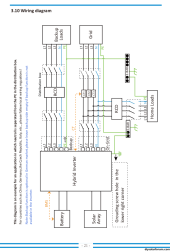Why so many ground (PE) wires?
Only one is required per piece of equipment.
It sounds like you have a lot of ground loops in your system.
It's not a ground
loop unless neutral-earth is bonded in multiple points. As I said, normally PE is NOT supposed to nor conducting any current.
And it doesn't change much if I have 1, 2, 3 or 4 PE wires on the same equipment. All it does is reducing the resistance of the connection. And provide some kind of redundancy if e.g. one connection is not properly making contact.
The fact that the Neutral current is being (partially) diverted through the PE wire is due to MULTIPLE BONDING points (Neutral-Earth), NOT the multiple PE wires. Although multiple PE wires might increase the amount (in %/A) of diverted current since the resistance of the PE connection is lower compared to the Neutral, as said before.
Why multiple PE wires ?
- 1 on Grid Terminal Block (as according to Manual)
- 1 on Load Terminal Block (currently disconnected while trying to see if this was causing the multiple Neutral-Earth issue, which caused the RCD to trip)
- 1 on Generator Terminal Block (currently disconnected while trying to see if this was causing the multiple Neutral-Earth issue, which caused the RCD to trip)
- 1 on Frame/Chassis (as according to Manual)
In the latest version of the Manual they don't show this internal Neutral-Earth bonding contactor anymore in the Schematic, so not sure what is going on.

I just hope that the modifications regarding RCD and Breakers will fix the Issue. I'm not a fan on reworking 100 times on the same panel. Just removing the PERMANENT bonding jumper was an absolute nightmare.
The EMC filter might also be causing sporadic trips. Although, while working with the PERMANENT BOND a few days ago (between RCD and EMC filter), that seemed to work correctly.



